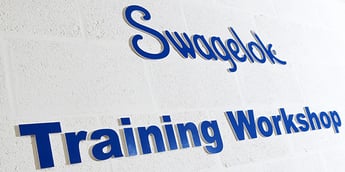Share this
A Mass Exodus of Talent Is Underway, Are You Prepared to Bridge the Skills Gap?
by Jeff Hopkins on 4/17/19 8:45 AM
As baby boomers retire, they take decades of knowledge and experience
"2 million engineering and manufacturing jobs will go unfilled as baby boomers retire"
- Prediction from Deloitte and The Manufacturing Institute
The baby boomers, the 78 million people born between 1946 and 1964, have spent their lives defining one societal change after another. Now they are leaving the workforce at a rate of about 1.2 million a year, and taking decades of institutional knowledge with them.
Who will replace them? The Millennial generation, born from the early 1980s to the mid-1990s, is big enough, but will those people walk in the door with enough skills and talent to replace the retirees who just left?
And in the San Francisco Bay area, with an exceptionally low unemployment rate, will you be able to find the ones with the right skills?
Four kinds of loss
When a retiree leaves a company, four kinds of experience-based knowledge disappear, according to the authors of the book "Critical Knowledge Transfer." The four areas are: relationships, reputation, re-work and regeneration. The authors brand these four areas collectively as Deep Smarts.
The loss of relationships is easy to comprehend. A new replacement often will be a stranger to all the people who were used to talking to the person who just retired. Handing the new person a list of contacts can help, but it doesn't say which people are best to call under which circumstances, and which ones are the most reliable.
Loss of reputation is also easy to understand. It will take time for the new hands to prove what they know. And if they can't draw on that deep well of expertise that their predecessor had, your company's reputation will suffer.
Re-work takes a little more explaining. "When the incoming successor has to spend time understanding product lines or critical processes, learning informal norms and ways to get things done, figuring out how organizational units interact — that’s all time-consuming, wasteful re-work," the authors write.
Then there's regeneration, the capability to bring out the next new product. "Innovation springs from fresh thinking, true. But it is also often built on years of experience and expertise with designing and producing a particular kind of product," the authors say.
If your company can easily hire someone new with the same know-how and skills (or even better skills), great. If you have been grooming a successor to take the reins, also great.
But during research interviews with executives and HR managers, the authors of "Critical Knowledge Transfer" discovered that managers often don’t know what they have lost until after the expert leaves — and by then, it may be difficult to recover. Writing in the Harvard Business Review, the authors said that the price tag associated with such losses can be as much as 20 times the more visible, tangible costs of recruitment and training.
Boom and bust
The skills gap is nothing new. The earliest boomers started retiring about 10 years ago, and demographers saw it coming long before that. But American industry has not made any progress in closing the gap. In fact, it is getting wider. In a report titled "The Skills Gap in US Manufacturing: 2015 and Beyond," consulting firm Deloitte and The Manufacturing Institute predicted that 3.4 million manufacturing jobs will likely be needed by 2025, but 60 percent of these positions are likely to be unfilled due to the talent shortage. Put another way, U.S. manufacturing sector is likely to suffer a shortfall of 2 million workers over that decade.
The same report noted that three-fourth of manufacturing executives expect to have trouble maintaining or increasing production to meet customer demand. Companies can try to make for a skills shortage by having their existing employees work overtime, but that's only a stopgap measure. It's expensive, and over time it wears people out and actually hurts productivity.
The Bay Area factor
Any company operating in the San Francisco Bay Area faces an additional challenge. The local unemployment rate near the end of 2017 was 3.1 percent. For comparison, the Federal Reserve has said that when the unemployment rate falls to 4.6 percent, just about everyone who wants a job has one.
That means nearly every skilled prospect in the Bay Area already likely has a job, and competition among employers is fierce.
Strategic thinking
A company can take several steps to close its own skills gap. Solutions include:
- Internal training programs. You know when your oldest workers will reach retirement age, so have them start passing along their expertise long before their retirement party.
- Flexible work arrangements. Not everyone wants to retire at 65, so don't automatically rush them out the door when they hit that milestone. Likewise, not everyone wants to work full time until the last moment. Give them the opportunity to taper off, perhaps working alongside their eventual replacement as a mentor.
- Partnering with schools. Get out and work with local universities, trade schools and high schools. Inspire young students to pursue careers in the fields you need. Make internships available.
- Outsourcing. You don't have to do everything yourself. Let your company concentrate on its core skills, and hand off specialty jobs, jobs that need to be done only periodically or jobs that require a large investment in specialized tools that would sit idle most of the time.
We can help
Swagelok Northern California can help you respond to the growing skills gap in important ways. We offer a wide variety of customer education and training programs to bring new industrial associates up to speed faster, or to keep seasoned employees sharp. This includes our quarterly training in tube fitting safety and installation and the basics of tube bending.
We also have an Assembly Services department that can assist you in solving fluid system design challenges, and assemble subsystems so that all you have to do is hook them up and get right to work. You can see our design optimization service in action in this video on our Check My Design page, and read about how other businesses benefited from our assembly services in these case studies.
Is the skills gap a concern for your team? We can help. Call us at 510-933-6200 or contact us through our website at https://northerncal.swagelok.com/ask

More like this:
Share this
- Archive (465)
- Assembly Services (207)
- About (100)
- Seal Support Systems (96)
- Best Practices (88)
- Training Services (74)
- Fittings (51)
- Semiconductor Applications (49)
- Hoses and Flexible Tubing (47)
- Regulators (44)
- Tubing (42)
- Grab Sampling Systems (32)
- Sampling Systems (32)
- Gas Systems (30)
- Services (30)
- Downloads (29)
- Valves (24)
- Application Support (18)
- Orbital Welding (17)
- Case Studies (13)
- Steam Systems (13)
- Frequently Asked Questions (12)
- Tools (12)
- Measurement Devices (7)
- Subsystems (6)
- Thermal Management (6)
- September 2023 (1)
- August 2023 (2)
- June 2023 (1)
- March 2023 (3)
- February 2023 (3)
- January 2023 (4)
- December 2022 (4)
- November 2022 (4)
- October 2022 (4)
- September 2022 (1)
- August 2022 (3)
- July 2022 (2)
- June 2022 (4)
- May 2022 (1)
- April 2022 (2)
- March 2022 (1)
- February 2022 (2)
- January 2022 (3)
- December 2021 (1)
- November 2021 (6)
- October 2021 (6)
- September 2021 (8)
- August 2021 (4)
- July 2021 (3)
- June 2021 (6)
- May 2021 (6)
- April 2021 (7)
- March 2021 (5)
- February 2021 (4)
- January 2021 (6)
- December 2020 (5)
- November 2020 (6)
- October 2020 (6)
- September 2020 (8)
- August 2020 (7)
- July 2020 (8)
- June 2020 (8)
- May 2020 (6)
- April 2020 (9)
- March 2020 (7)
- February 2020 (10)
- January 2020 (21)
- December 2019 (23)
- November 2019 (21)
- October 2019 (22)
- September 2019 (21)
- August 2019 (22)
- July 2019 (23)
- June 2019 (20)
- May 2019 (23)
- April 2019 (22)
- March 2019 (21)
- February 2019 (20)
- January 2019 (21)
- December 2018 (14)
- November 2018 (19)
- October 2018 (23)
- September 2018 (17)
- August 2018 (29)
- July 2018 (11)
- June 2018 (6)
- May 2018 (5)
- April 2018 (4)
- March 2018 (5)
- February 2018 (3)
- January 2018 (3)
- December 2017 (2)
- November 2017 (4)
- October 2017 (3)
- September 2017 (2)
- August 2017 (6)
- July 2017 (4)
- June 2017 (4)
- May 2017 (4)
- April 2017 (3)
- March 2017 (4)
- February 2017 (3)
- January 2017 (3)
- December 2016 (3)
- November 2016 (3)
- October 2016 (3)
- September 2016 (5)
- August 2016 (5)
- July 2016 (4)
- June 2016 (5)
- May 2016 (3)
- April 2016 (4)
- March 2016 (5)
- February 2016 (11)
- January 2016 (1)
- December 2015 (3)
- November 2015 (4)
- October 2015 (3)
- September 2015 (4)
- August 2015 (4)
- July 2015 (8)
- June 2015 (5)
- May 2015 (3)
- April 2015 (4)
- March 2015 (4)
- February 2015 (3)
- January 2015 (4)
- December 2014 (2)
- November 2014 (3)
- October 2014 (4)
- September 2014 (4)
- August 2014 (4)
- July 2014 (5)
- June 2014 (4)
- May 2014 (4)
- April 2014 (5)
- March 2014 (4)
- February 2014 (3)
- January 2014 (4)
- December 2013 (5)
- November 2013 (3)
- October 2013 (4)
- September 2013 (3)
- August 2013 (5)
- July 2013 (5)
- June 2013 (5)
- May 2013 (3)
- April 2013 (6)
- March 2013 (4)
- February 2013 (4)
- January 2013 (8)
- December 2012 (4)
- November 2012 (6)
- October 2012 (6)
- September 2012 (4)
- August 2012 (4)
- July 2012 (4)
- June 2012 (4)

.webp?width=210&height=70&name=StickyLogo%20(5).webp)

